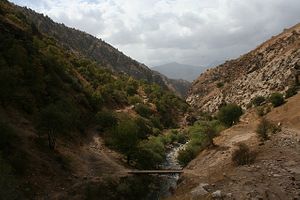In the last couple of days, it was reported that a Chinese company, TBEA, has been granted a license to operate the Upper Kumarg gold mine in northern Tajikistan in exchange for the construction of a power plant in Dushanbe. This is likely to be true. It is the culmination of a long-standing agreement that began almost a decade ago.
This article goes through the project step by step to show that this was a carefully (and slowly) negotiated deal between the company and the Tajik government. It all happened before the project was constructed. To my knowledge, there have been no other major recent resource-for-infrastructure deals between China and Tajikistan. These are not the preferred option for either side.
The power plant, Dushanbe 2, is a combined heat and power plant (CHP) which provides heat and electricity for citizens of Dushanbe. It only operates in the winter. The project, in its final form, consisted of two phases. Phase 1 (constructed in 2012-2014) installed capacity of 100 MW and phase 2 (constructed in 2014-2016) installed an additional capacity of 300 MW.
The project hearkens back to 2009 when the Ministry of Energy and Industries (later called the Ministry of Energy and Water Resources) and TBEA signed a memorandum of understanding for the construction of a 200 MW coal power station in Dushanbe (as well as two other projects that never came to fruition). Even at this early stage, the MoU explicitly stated TBEA would receive access to resource deposits in return for these projects.
Construction of the CHP didn’t start for three years due to negotiations over funding. In 2011 TBEA Chairman Zhang Xin responded on the TBEA website to an investor’s question (the link does not always work – readers can contact the author for a cached version):
Regarding the initial contract for the 270MW [200MW in original MoU] thermal power station in Dushanbe signed between Tajikistan and our company, the financing and construction method for this project are currently being actively discussed with Tajikistan’s Energy Ministry [Ministry of Energy and Water].
In a September 2012 interview, Zhang said the company would build a 100MW (smaller than the originally planned 200 MW) coal-powered CHP in Dushanbe. TBEA would front the construction costs for $178 million by borrowing directly from China Eximbank. In return, the Tajik government would grant TBEA rights to explore and develop gold deposits at the Eastern Duoba mine and the Upper Kumarg mine (the one reported on in the last few days). This would become phase 1 of the project.
At some point during the negotiation process, the Tajik Government sought to borrow money directly from international concessional loan providers, presumably including China Eximbank. But that was to no avail. Tajik Minister of Energy and Water Resources Usmonali Usmonov said: “It has practically been impossible to attract funds from international financial institutions for construction of the Dushanbe-2 CHP plant…..When the project is not designed for the year-round operation, it cannot be efficient, and therefore, nobody wants to finance such projects.”
Phase 2 was funded under a different arrangement. Eximbank directly issued $331 million to the Tajik Government – to be paid back through regular government-to-government loan repayments. Neither Eximbank nor the Tajik government has publicly explained why they agreed to loan directly to the Tajik government for phase 2 of the project but not phase 1. One very plausible explanation is that political pressure was applied before Xi Jinping’s visit to Tajikistan for the SCO Leader’s summit in September 2014. The contract for phase 2 was signed at the summit.
Both phases have now been completed, and the Tajik government needs to start paying up. In 2014, TBEA was granted licences to explore these deposits. It seems TBEA has now been granted full mining licences for both mines.
According to TBEA Chairman Zhang Xin, the Tajik government also agreed to give TBEA the rights to further mining deposits (the location was not identified) if the profit made from the gold deposits doesn’t cover the cost of building the power plants.
The Tajik government will in the future have to pay back the $331 million to Eximbank – through normal repayment channels. This is a highly concessional loan.
The second phase of the project shows a far more common Chinese approach to loans in Tajikistan. In fact the vast majority, if not all, government-to-government loans between China and Tajikistan have been conducted in this way. All indications are that this will continue to be the case.
Dirk van der Kley is a Research Fellow at Narxoz University and a PhD Candidate at the Australian National University.

































